With Amazon Fresh, Amazon has stamped its brand on what’s shaping up to be a full-fledged, brick-and-mortar supermarket chain. Still unclear to competing grocery store retailers, however, are the e-tail giant’s ultimate plan for Amazon Fresh and its potential for disruption.
Seattle-based Amazon opened its first Amazon Fresh store in late August 2020, a 35,000-square-foot location in Woodland Hills, Calif. It now has 29 Amazon Fresh supermarkets in six states — California (13 stores), Illinois (seven), Washington (four), Virginia (two), Maryland (one) and Pennsylvania (one) — and Washington, D.C. (one), ranging from about 25,000 to 45,000 square feet. The most recent opening came in late April, a 35,000-square-foot Amazon Fresh in La Verne, Calif. The banner’s 30th location, another 35,000-square-foot store, is slated to open in Murrieta, Calif., on May 5.
According to Jeff Helbling, vice president of Amazon Fresh Stores, new Amazon Fresh locations are planned for California, Illinois, Pennsylvania, Virginia, Washington state and New Jersey, though he didn’t specify the number of units or an opening timetable. Amazon, too, has begun hiring for an upcoming Amazon Fresh in Oceanside, N.Y., which would be the banner’s first location in the Empire State.
“We’re thrilled about the customer response to Amazon Fresh stores. Our efforts to evolve our grocery experience into a seamless, omnichannel offering have been well-received by shoppers and the industry,” Helbling told Supermarket News in an email interview. “Earlier this year, Amazon Fresh was named the fifth-best U.S. grocer on dunnhumby’s Retailer Preference Index — a solid ranking for our first time on the list. And a contributor to Forbes included the opening of our first Amazon Fresh store with Just Walk Out technology as ‘headline of the year’ in his 2021 Retail Award list. We have exciting plans for Amazon Fresh stores this year and in the future.”
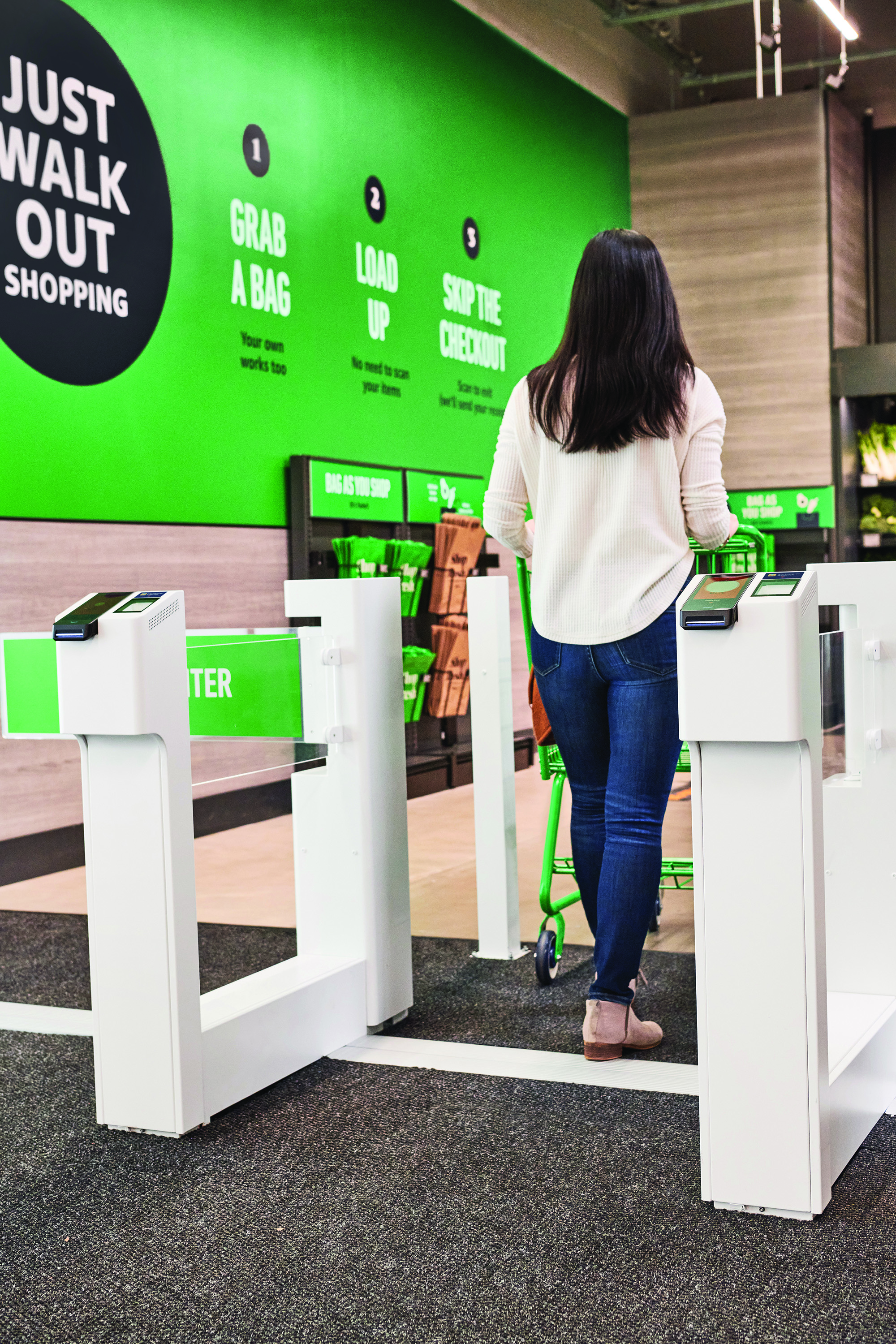
When shoppers exit Amazon Fresh stores equipped with Just Walk Out technology, the app automatically debits their Amazon account for the items they take. (Amazon)
Given Amazon’s propensity for innovation and vast resources, brick-and-mortar grocers are justified in being concerned about Amazon Fresh, industry observers say. But they note that Amazon remains in a learning phase in both grocery and physical retail, even after nearly five years of owning Whole Foods Market.
“Amazon isn’t a traditional grocer. They don’t come at the physical grocery space from the same perspective. Their motivations may be slightly different based on the fact that the larger part of their business isn’t physical, but digital,” said David Bishop, partner at Brick Meets Click, a Barrington, Ill.-based strategic advisory firm focusing on how digital technology impacts food sales and marketing.
“They have an incredible wealth of market intelligence relative to their customer base, both from Prime members as well as non-Prime members. I think, right now, they’re taking advantage of a marketing environment where there’s a lot of real estate available,” Bishop explained. “I’m sure there are certain criteria they’re looking at relative to square feet, lot size, traffic patterns and demographics. But when you sit back and see what they’ve done in the range of places that they’ve done it, you come away realizing they’re still in learning mode, because most conventional grocers wouldn’t be following this path of expansion.”
Amazon’s push to build Amazon Fresh from the ground up reflects, in part, the allure of the food retail market, said Amanda Lai, senior consulting manager and food retail practice lead at Chicago-based retail consultancy McMillanDoolittle.
“I would anticipate that Amazon has its sights set on continuing to grow Amazon Fresh to be regional, if not national. When you look at all the different retail categories, food is one of the most reliable in terms of recurring sales,” Lai said. “All of their decisions are data-driven, and just the size of the overall food market opportunity — as well as the efficiencies they can draw from omnichannel capabilities — create quite an attractive proposition for Amazon to be tackling the grocery industry. Their existing strategy of signing leases would suggest that they’re well on their way of continuing to grow.”
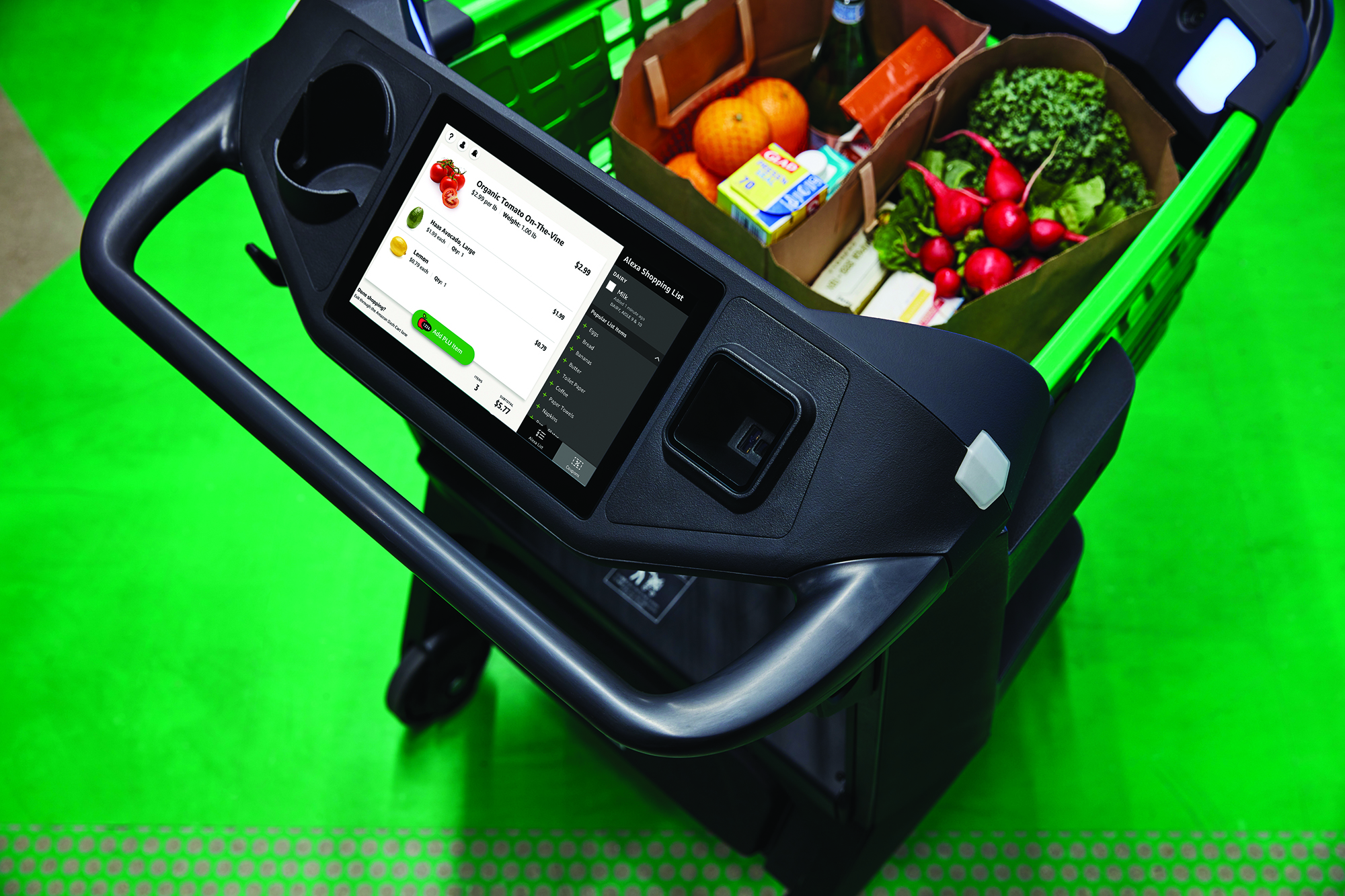
Amazon’s Dash Cart “smart” shopping carts use computer vision algorithms and sensor fusion technology to identify items that customers place in its basket.
New type of grocery store
When Amazon Fresh made its debut in Woodland Hills in 2020, the concept was touted as a new approach to the supermarket, offering a seamless shopping experience whether customers are in-store or online.
Technology plays a big part. A “smart” shopping cart called the Amazon Dash Cart helps customers find products, automatically identifies items placed in the cart and keeps a running tally. To pay, shoppers walk through a special Dash Cart lane, where sensors identify the cart and the items selected, and the transaction is processed using the credit card on their Amazon account — without a stop at the register.
Amazon’s Alexa virtual assistant, accessed via the Dash Cart or at an in-store station, also helps customers manage shopping lists, find items in the store and access food-related information. An Amazon app tool dubbed Order Ahead lets Amazon Fresh shoppers place deli, meat, pizza and seafood orders; shop while they’re being prepared; and be notified when their items are ready for pickup at the service counter.
Same-day grocery delivery and pickup also are offered directly from Amazon Fresh stores, and customers can retrieve their orders at a service counter or by parking in a designated pickup spot. “A big portion of their strategy is thinking about their e-commerce reach in terms of location, not just necessarily what’s prime real estate,” Lai said.
Amazon Fresh, too, serves as a site for Amazon.com order pickup and product returns.
“As is true across all of our businesses, if we see an opportunity to deliver something different or better to meet a customer need, we do it. And that’s what we’re doing with our Amazon Fresh business,” Helbling said. “We’re serving customers in ways they prefer to be served, which includes physical stores and, increasingly, omnichannel shopping.”
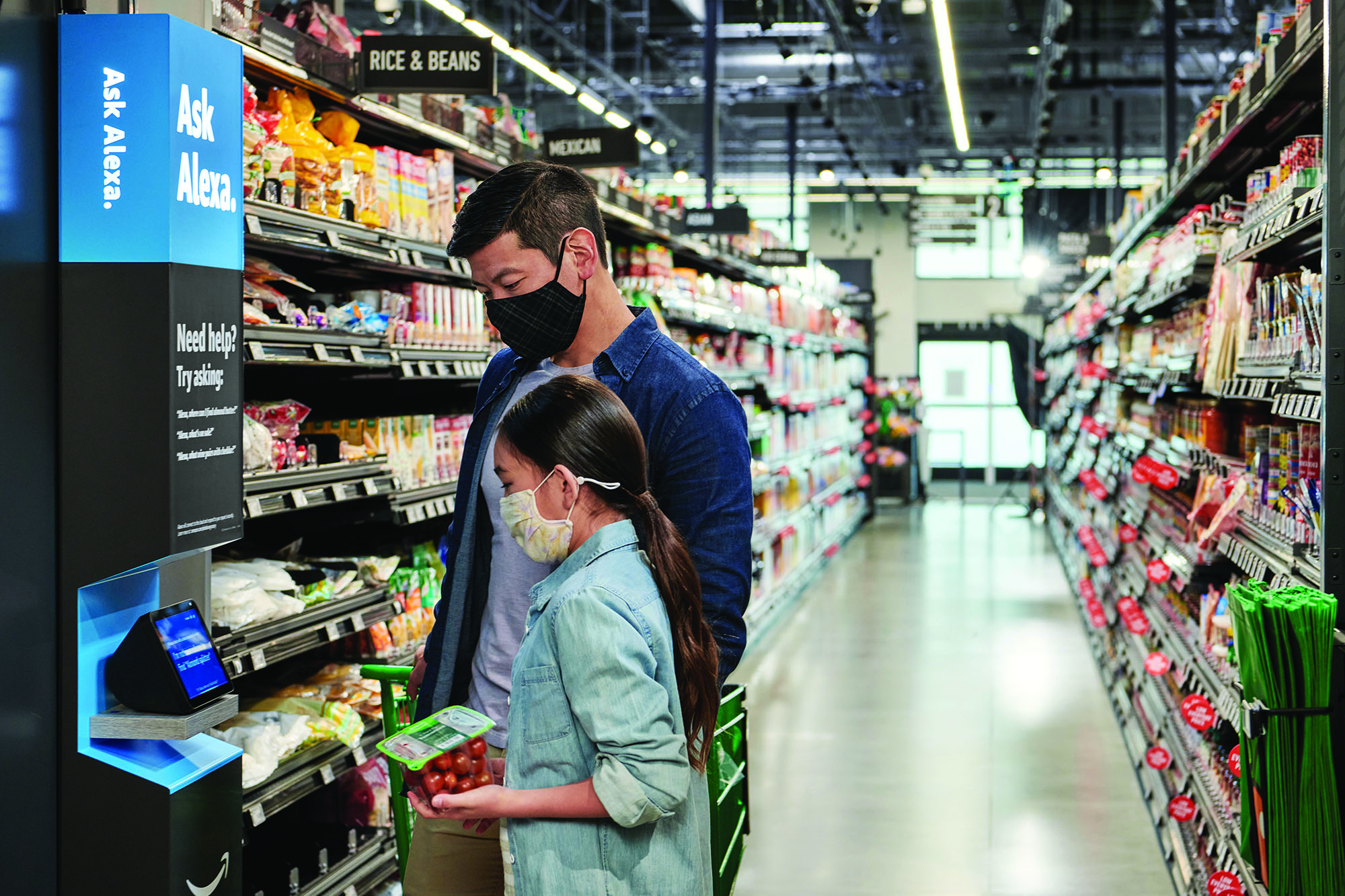
Amazon’s Alexa virtual assistant, accessed at an in-store station, helps customers manage shopping lists, find items in the store and access food-related information.
More recently, that has included Just Walk Out, the “cashierless” platform pioneered in the smaller Amazon Go convenience stores. Last June, the opening of a 25,000-square-foot Amazon Fresh in Bellevue, Wash., marked the banner’s first location with Just Walk Out and the platform’s first application in a full-size grocery store. Eleven Amazon Fresh stores now offer the technology, with the other 16 providing the Dash Cart.
“We’ve introduced new ways to make grocery shopping more convenient, including our Just Walk Out technology and the Amazon Dash Cart, which enable customers to skip the checkout line,” Helbling noted. “Additionally, customers in our Amazon Fresh stores can engage with Alexa features to help them manage their shopping lists and better navigate our aisles. Our Amazon Fresh store shopping experience puts all of these innovations at the center to save customers precious time while they shop and check out of the store.”
Just Walk Out uses overhead computer-vision cameras, weight sensors and deep-learning technology to detect merchandise that shoppers take from or return to shelves and track items selected in a virtual cart. At the store’s automated entry gates, customers are prompted to select Just Walk Out shopping or use traditional checkout. Those choosing Just Walk Out enter by scanning the QR code in the Amazon app, scanning their palm on the Amazon One palm signature device, or inserting a credit/debit card linked to their Amazon account. When shoppers exit the store (the same way they entered), Just Walk Out debits their Amazon account for the items they took and sends a receipt to the app.
“The customer response to innovations like the Dash Cart and Just Walk Out shopping in a full-size grocery store has been tremendous,” according to Helbling. “They’re critical differentiators that make grocery shopping more convenient than ever for shoppers,” he said. “We’ve had terrific feedback from customers on our in-store tech, and we continue to look for ways to evolve our technology — and bring innovation in from other parts of Amazon — to deliver a great experience for customers. Customers consistently rate our store experience as more convenient because it helps them save the hassle of standing in a checkout line, the least fun part of grocery shopping.”
What food shoppers want most
Though technology and e-commerce get much of the spotlight, good food and value for the money — as with any supermarket — are key to Amazon Fresh’s appeal.
Amazon Fresh stores serve up a curated assortment of competitively priced national, regional, local and Amazon own brands, geared toward a weekly trip. The stores also offer an ample selection of fresh produce, meat and seafood plus a range of prepared foods made in-store, including freshly baked bread, hot and cold bars, fresh sushi, made-to-order pizza and hot sandwiches.
“At Amazon, we obsess over customers, so we focus on what we know shoppers at our stores are looking for — low prices, a great selection and convenience,” Helbling said. “Our prices are extremely competitive, and we have consistently low prices on items like bananas for 15 cents, freshly baked bread for 89 cents, and hot, fresh rotisserie chickens for $4.97.”
National brands at Amazon Fresh include staples like Coca-Cola and Kraft Mac & Cheese alongside local brands such as Rockenwagner Bakery and Groundworks Coffee in Los Angeles; regional favorites like Duke’s Mayo and Ellenos Yogurt; international brands such as Kewpie Mayonnaise; and a phalanx of own brands like the Amazon-exclusive Fresh and Cursive labels and the 365 by Whole Foods Market organic brand.
“We’re incredibly proud of the food we offer — as just one example, the private brands that we’ve developed exclusively for Amazon Fresh customers, whether they’re shopping in-store or online. And we’re even more pleased with customers’ response to them. Customers absolutely love the wide selection of products they can find from Amazon Kitchen, Cursive, Fresh and Happy Belly, noting their satisfaction with an average 4.6-star rating for items across our portfolio,” Helbling said.
“As COVID-19 restrictions start to loosen, we’ve been able to fully implement features like our self-serve hot and cold bars and in-store dining areas,” he added. “And we’ve evolved our selection to include local brands in our stores and some new products in response to customer feedback. We’ve also launched a new private-label brand, Aplenty, and we continue to expand our other private-label product offers, like with the launch our new plant-based product line under the Fresh brand.”
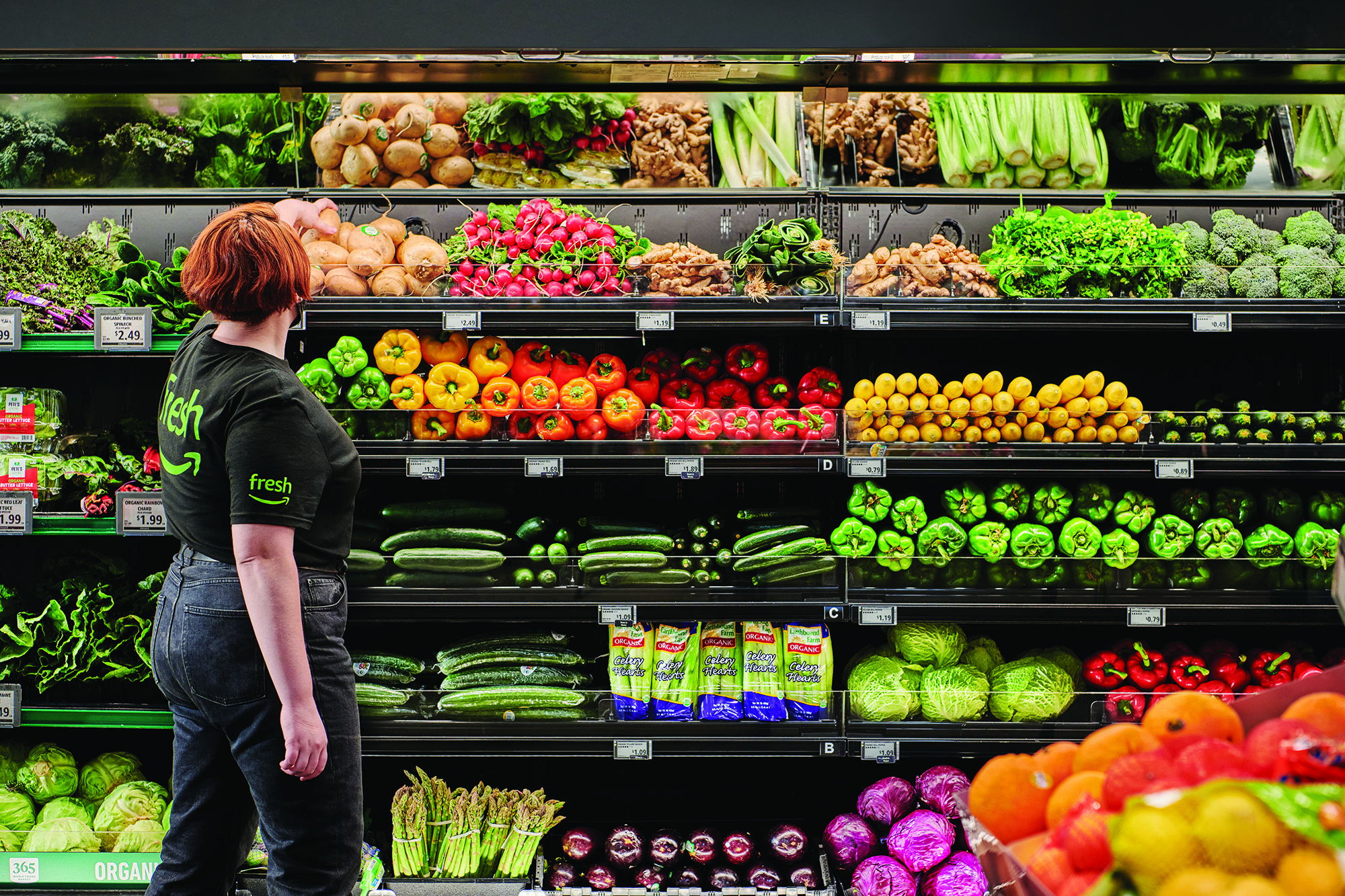
Amazon opened its first Amazon Fresh store in late August 2020, and now has 29 Amazon Fresh supermarkets in six states.
Amazon Fresh is well-differentiated from its sister food retail chains Whole Foods and Amazon Go, as each banner serves a different purpose, according to Helbling.
“Whole Foods Market is a pioneer in natural and organic groceries, and Amazon Go focuses on ready-to-eat food and beverage items that are convenient for customers to grab,” he said. “Amazon Fresh stores are full-size grocery stores focused on everything customers want for their weekly shop.”
Challenging conventional supermarkets
That focus on the weekly food shopping trip — combined with an affordable price point, curated selection and convenience features — puts Amazon Fresh directly up against traditional supermarkets, industry analysts say.
“They’re really going head to head with more of the mainstream grocers,” McMillanDoolittle’s Lai said, noting that traditional grocery offers Amazon “the biggest slice of the pie” in terms of potential market share.
“Amazon Fresh is positioned best to compete against the conventional supermarket — so the Krogers, the Albertsons, the Walmarts of the world,” she said. “Those that have a more differentiated positioning, such as the hard discounters, the club formats and the premium gourmet concepts, are better-positioned to defend against Amazon, largely because they’re going after different customer types and shopping occasions.”
Grocers not standing out from the crowd in any particular variable are most susceptible to competition from Amazon Fresh, Brick Meets Click’s Bishop said.
“Clearly, where Amazon is going to be the threat with their Fresh physical store is the conventional grocer — in particular, those grocers who are ‘stuck in the middle.’ They’re not the low-price leader, and they are not really differentiated on the high end with quality and service. Those are the retailers who are vulnerable, and I think Amazon has sensed, rightly so, that that’s the market most ripe for disruption,” he explained.
“As a result, you’ll see less impact on someone like Walmart, Target or Aldi on the lower end. On the higher end, the degree of cross-shop between Amazon Fresh and Whole Foods is nominal compared to the cross-shop with a conventional grocer,” Bishop said. “So those [traditional grocery] customers kind of sense that this may be an alternative worth trying. The question is whether they see it as an acceptable alternative going forward relative to where they currently shop.”

‘The technology at Amazon Fresh, that’s a point of difference,’ said David Bishop of Brick Meets Click. ‘Whether that is a point of competitive advantage, that remains to be seen.’
The degree of value that consumers attach to Amazon Fresh’s tech-driven convenience and omnichannel benefits will be a linchpin of its success, according to Lai and Bishop.
“The in-store technologies such as Just Walk Out and the Dash Carts are a novelty that will have customer appeal and draw customers in to the check out the stores,” Lai said. “What will retain customers in the long run are the level of integration with their e-commerce platform and having that single view of the shopping experience — both your online orders and Amazon Fresh orders in one place — and their ability to deliver on the products that customers want.”
Brick Meets Click’s analysis of Amazon Fresh stores found that the technology isn’t without potential friction points. For example, Bishop said, the Dash Carts cannot be taken out of the store, meaning customers must transfer to a standard cart or carry their groceries to their cars. The carts also are designed for small- to medium-sized grocery trips, accommodating just two full bags. In his store visits, Bishop said he found the Alexa Shopping List capability on the Dash Cart to be a cool feature, whereas the functionality of the in-store Alexa station proved “fairly limited.” One time, he also encountered difficulty in getting the smart cart to detect some items put in the basket.
“The technology, that’s a point of difference,” Bishop said, citing the Dash Cart and especially Just Walk Out. “Whether that is a point of competitive advantage, that remains to be seen, because we see relatively low adoption rates with those technologies, which would be reflective of the consumer perception of the benefits associated with those features.”
Still, the innovation brought by Just Walk Out “creates an opening for transforming the way that people shop,” Lai observed. “The technological component really opens the door for new ways of going to market with retail, not just limited to grocery,” she said. “The Just Walk Out technology fundamentally changes the way you can design a store.”
Points of differentiation
Service and assortment stand out as areas where conventional supermarkets can more than compete with Amazon Fresh.
“One of the major callouts of the Amazon Fresh grocery shopping experience is that there really isn’t much of a service component,” Lai said. “When you bring in technology to reduce interaction with staff, you do lose that element of service. There is a customer that is looking for an experience like that, but you have many other competitors that have been in the business for a long time that are anchored on differentiating for service, for knowing their customers’ names, for having a more high-touch product offering. There is still always that component of soft skills that shape the customer’s experience. That’s not necessarily being covered in the Amazon Fresh experience today.”
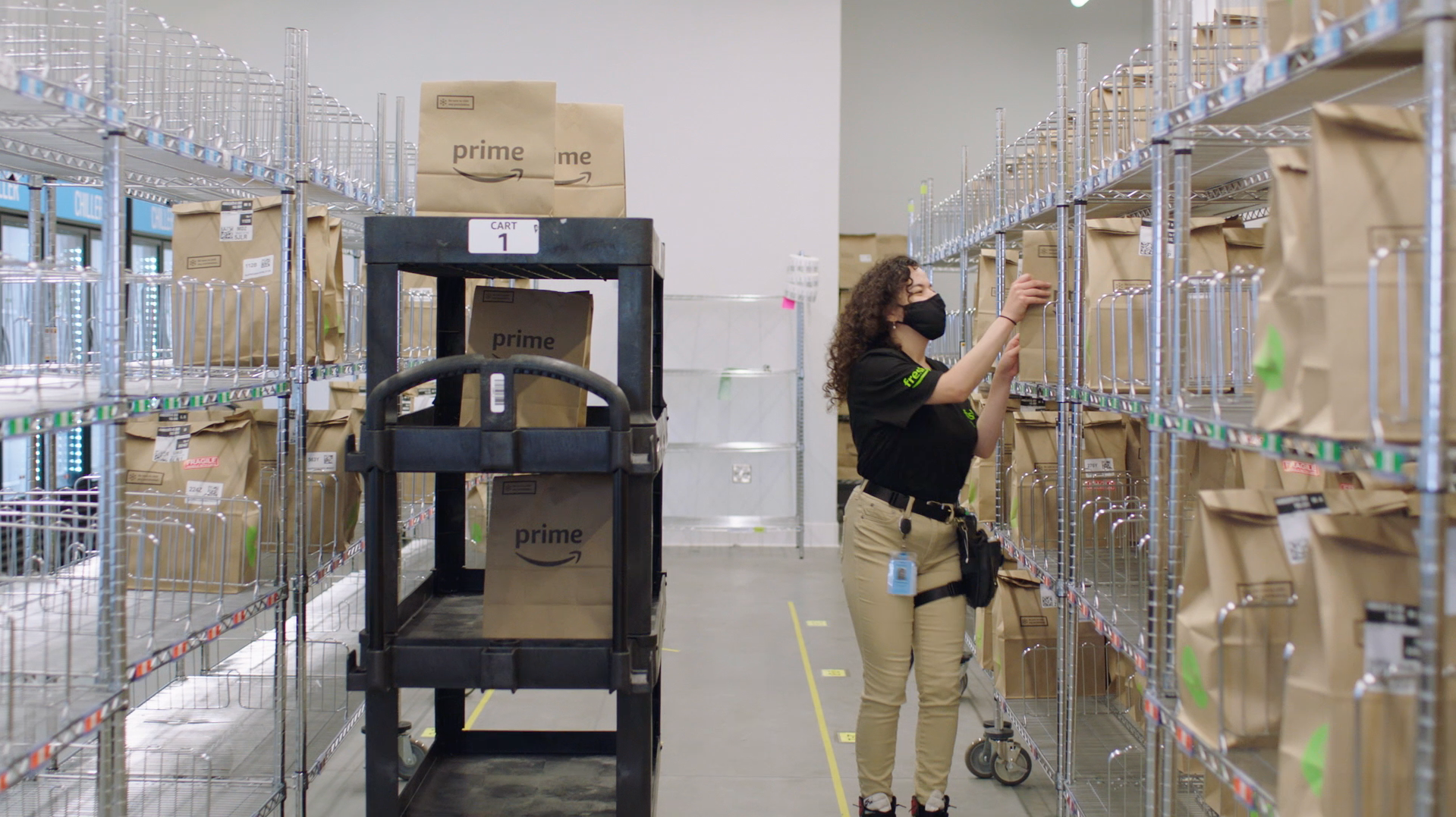
Orders for pickup and delivery are prepared at an Amazon Fresh store.
Amazon Fresh is priced roughly at parity with traditional supermarkets but, as a result of its store size and curated selection, offers about 40% of a conventional grocer’s assortment, Bishop estimated.
“The perception a customer would have is Amazon Fresh has a wide range of products available that I typically would buy. You generally would find your most popular products and brands there. Where you would start to notice the abbreviation are in categories where your preferred brand isn’t available or where the assortment is grossly lower,” he said.
Lai explained, “They’re leveraging data from their online sales. That shows in its assortment and how you’ll have a lot of those key national brands represented but won’t necessarily get more of those unique-flavored SKUs or more local and niche brands, because it is largely driven by that online data. They’re not going to stock a product that’s not going to turn.”
That isn’t necessarily a bad thing, Bishop noted. “The question really is, does that matter? What that really calls out is that conventional grocery stores are over-SKU’d — and by a large percentage, you could argue. This is the case for why we need to see more SKU reduction or rationalization in the grocery space,” he said. “So, in some ways, they could be ahead of the curve by following this assortment strategy. But in some cases, they could be missing sales opportunities by overly curating that assortment.”
Amazon Fresh’s speed and convenience cater more toward quick shopping trips, whereas traditional supermarkets focus on the bigger-basket, higher-ring stock-up trips supplemented by fill-in shops, Bishop pointed out.
“The core part of most conventional grocers’ business is the stock-up and fill-in trips. That would generally represent 70% to 80% of the volume sales,” he said. “The Amazon Fresh store, interestingly, is targeting more of the quick trip. So that would be about 50% of the trips to a traditional grocery store but represent maybe a third of the sales. You can see that in the way they’ve merchandised it, and the use of some of these technologies caters more toward a lower basket.”
Staying power
This year, Amazon Fresh made its debut at No. 5 on dunnhumby’s Retailer Preference Index (RPI), the customer data science firm’s annual grocery retail ranking, behind only parent company Amazon, H-E-B, Market Basket and Wegmans and ahead of top banners such as Aldi, Trader Joe’s, Sam’s Club, Costco and Walmart Neighborhood Market. Dunnhumby cited speed (easy in and out, fast checkout) and digital (easy shopping online or with an app, useful information) as Amazon Fresh’s chief competitive advantages, and operations (e.g. out-of-stocks, price consistency, right products, clean stores) as its main disadvantage.
“I’d say right now they [Amazon Fresh] are getting a lot of halo just from the brand, because they have the word ‘Amazon’ in it. So I’m not exactly sure how to read them. Their [RPI] scores and position and a lot of things are pretty close to Amazon,” Eric Karlson, director of customer strategy and insights at dunnhumby, said in a session at the recent FMI Midwinter Conference. “We’re going to have to see how they evolve. But they are the going at the market in the right way, with really robust quality at a really good price. So their value core is quite strong, and they could be a very difficult competitor when they get figured out and all the bumps ironed out.”
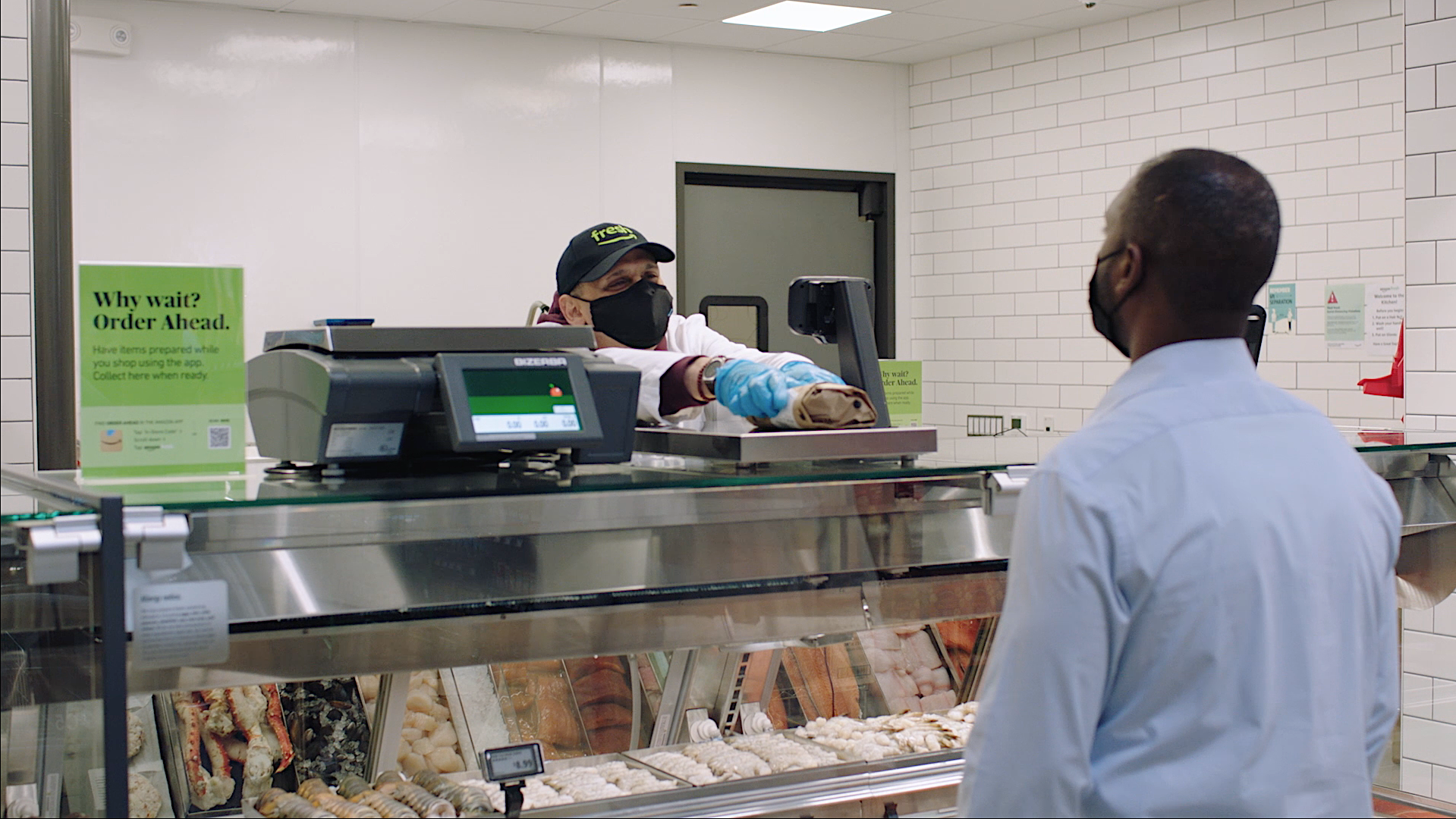
The Order Ahead app lets Amazon Fresh shoppers place deli, meat, pizza and seafood orders; shop while they’re being prepared; and be notified when their items are ready for pickup at the service counter.
Of the 60 grocery retailers evaluated in dunnhumby’s 2022 RPI, Amazon Fresh finished high in the first quartile in the balance of customer benefits (perceptions of product quality, experience quality, time savings) versus customer costs (perceptions of prices, promotions, rewards). Also in the first quartile were Amazon and H-E-B at the top, along with Target, Trader Joe’s, Sam’s Club, Costco, Wegmans, Market Basket, Walmart Neighborhood Market and Fareway. Amazon Fresh also made the RPI’s digital first quartile, behind only Amazon and ahead of Target, Walmart and Sam’s Club.
“They’re experimenting a lot. It’s hard to see as a customer or an observer exactly what those experiments are, but no doubt they’re testing a lot of stuff,” Grant Steadman, president of dunnhumby North America, commented in the FMI session. “They have done some great things on private label that have been really strong. The pricing is good. And they will be expanding a lot. I think that’s something they’ve announced, as we could expect hundreds of stores over the coming years.”
Karlson added, “And they don’t have to be profitable. What a nice thing.”
In terms of new stores and added square footage, real estate and investment management firm Jones Lang LaSalle (JLL) ranked Amazon Fresh as the sixth fastest-growing grocer in 2021, behind Aldi, Publix, Grocery Outlet, Giant Eagle and Sprouts Farmers Market but ahead of Schnuck Markets, ShopRite, Hy-Vee and Whole Foods.
“We continue to invest in and grow Amazon Fresh, building on our vision to expand our omnichannel offering, and also continue to innovate in the areas we know matter to customers — low prices, broad selection and convenience,” Helbling said.
According to digital marketing firm InMarket’s Amazon Brick & Mortar InSights Report, total visits to Amazon Fresh stores climbed 58% in the 2021 fourth quarter. The banner also saw a 108% gain in micro visits — shopping trips of less than five minutes — and a 65% uptick in new visitors, while average dwell time declined 29%.
Retail foot traffic specialist Placer.ai analyzed traffic at eight Amazon Fresh stores open about a year (five locations in California, three in Illinois) and found that all saw monthly store visits rise from the second to fourth quarters of 2021. At the same time, the Placer.ai report showed, six of the stores’s “true trade areas” — how far 70% of customers travel to reach the location — saw their square-mile reach shrink from Q2 to Q4. But the rise in visits suggested that the stores are getting better at catering to local customers, thus drawing more foot traffic from a smaller area, the Placer.ai report said.
For stores open a year or more, after shoppers had a chance to experience Amazon Fresh, “the deals went away, and so did the customers,” Bishop said, citing Brick Meets Click’s observations.
“They probably run at about one third to 40% of the traffic of the conventional [grocer] nearest to their store. And when we look at traffic patterns a year after opening, they’re also about one-third of that first month’s traffic. So, clearly, they still have a lot to work to do to convince customers that this is a place that makes sense for them to do their weekly or daily shopping,” he said.
“But the bigger picture is what role grocery plays and physical grocery plays within the broader ecosystem for Amazon,” Bishop added. “That’s the $60,000 question.”


